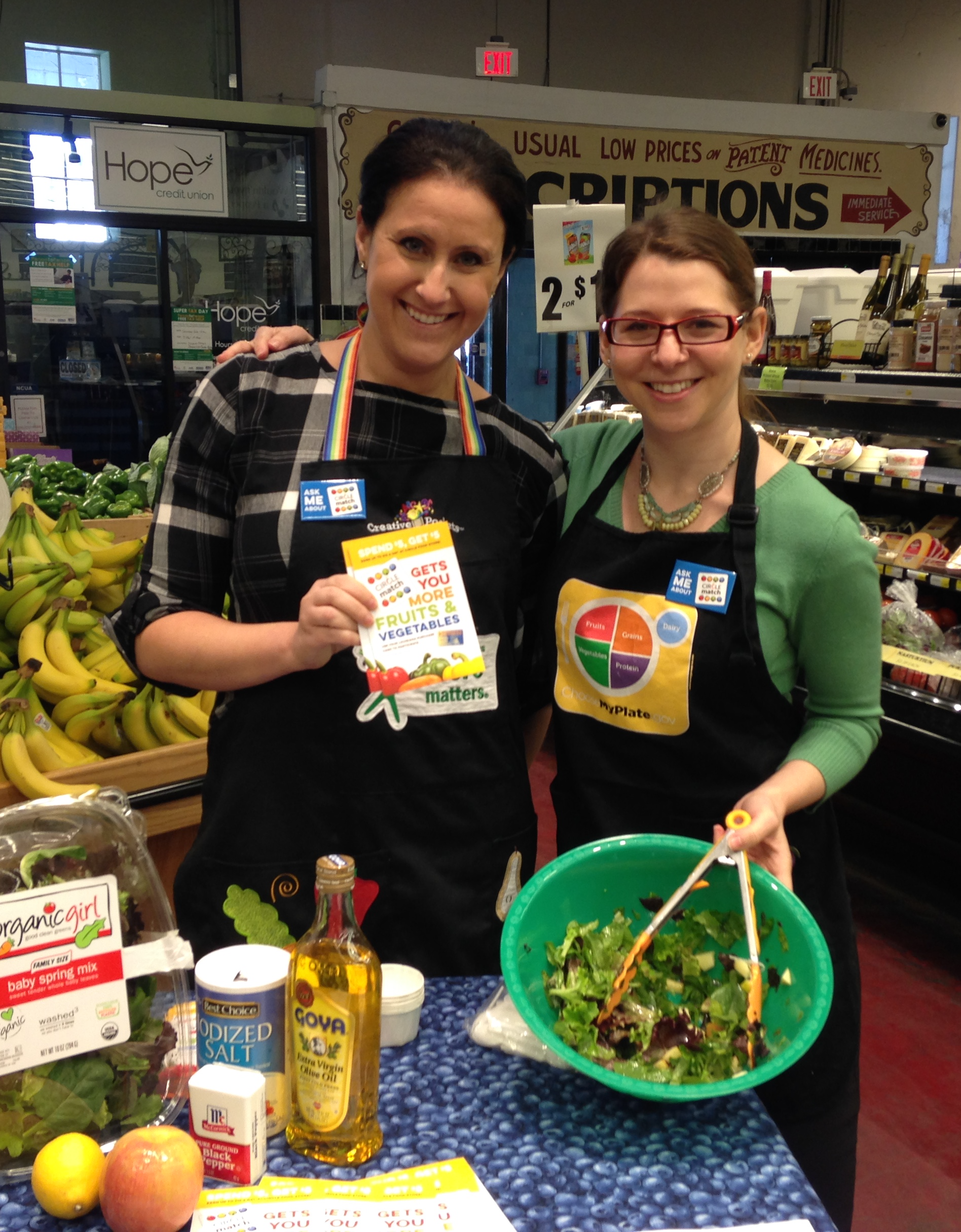
The Radical Potential of Fresh Food — and Why It Can Be So Hard to Come By
The Food Trust, a 26-year-old Philadelphia-based organization devoted to making healthy food affordable and accessible, works for food justice on both the grassroots and federal levels. Koprak recently spoke to Eleanor J. Bader about The Food Trust’s work alleviating hunger, improving nutrition, and expanding the food options available to low-income communities.
Eleanor J. Bader: The Food Trust website lists numerous cities—among them Baltimore, Milwaukee, Niagara Falls, New Orleans, Pittsburgh, and St. Louis—where poor people have little-to-no access to fresh fruit and vegetables. Why is this?
Julia Koprak: There are a lot of factors at play. For example, grocery stores run on razor slim profit margins, farmers’ markets can’t run themselves, and many small store operators don’t have the training or equipment needed to sell produce. In addition, when state governments talk about economic development, they’re typically talking about attracting corporations and don’t see the role grocery stores can play in a community’s economic growth. Worse, because of redlining, banks have historically been reluctant to provide loans to businesses in low-income neighborhoods, so someone wanting to open a grocery store will often find it hard to set up a trust deed. Since the profit margin for food sellers is only around one percent, grocery stores usually need an infusion of start-up cash to build out. Once they’re over this hurdle and have hired staff, the business can become more profitable long-term.
EJB: What can government do to change this?
JK: Government and other financial stakeholders need to put money in place if they truly want people to have the better health outcomes that come from improved nutrition. This is why The Food Trust tries to bring different constituencies to the table.
For example, we did work in New Orleans after the devastation of Hurricane Katrina in 2005. Our partners were Tulane University and the Second Harvest Food Bank and we focused on policy solutions to improve food access. It took a lot of work, but after passage of the New Orleans Fresh Food Retailer Initiative in 2011, entrepreneurs were able to obtain flexible financing to develop new businesses and expand or rehab existing ones.
One of the stores that reopened was the Circle Food Store, the oldest African American owned grocery in NOLA. After Katrina, the store was under five feet of water. The process of reopening was obviously going to be arduous because so much needed to be done, but Circle Food was the place people in the Seventh Ward, the neighborhood of Treme, shopped and it was an important community hub. Thanks to a mix of loans and grants, $9 million in all, the store was finally able to reopen in 2014.
This financing model is now used nationwide thanks to legislation called the Fresh Food Financing Initiative (HFFI). HFFI has helped in establishing everything from farmers’ markets and food coops, to 40,000 square-foot grocery stores.
EJB: Why has it been so challenging to get small stores to sell fresh produce?
JK: First, let me say that research shows that low-income people want perishables just as much as higher-income people, but small stores often don’t receive the technical help they need with distribution and storage. On the other hand, junk food sellers routinely give store owners free shelving and product placement signs, but a cooler owned by a soda company, for example, can’t be used to sell cantaloupes. It can only be used with that particular soda product. This means that small store owners may need help getting a refrigerator so that fresh produce doesn’t rot. They may also need help with pricing, signage, and setting up an attractive, culturally-appropriate food display that will appeal to shoppers.
We try to connect store owners with wholesalers to make the logistics easier, maybe even arranging deliveries. The owners’ response to this has varied, but in Philadelphia we’ve seen dozens, if not hundreds, of stores express interest in selling healthier items, from low-sodium products, to whole grains, to fresh produce.
But our programs are more extensive than this. Our Heart Smart program, for one brings blood pressure screenings to corner stores and offers taste tests of different foods. Across the board we’ve seen an increase in the sale of the healthier items that we’ve introduced when we do this.
EJB: What have you done to encourage kids to eat healthier meals and snacks?
JK: When we go into schools or youth centers we test recipes and try to get kids to try new items. It’s not just handing someone a piece of raw kale and hoping they’ll like it!
For many kids, it’s a unique experience to have someone come into the classroom and make something for them to eat. By making food accessible, and by making the presentation enjoyable, they engage. A lot of students we meet have direct experience with someone who is suffering from Type II diabetes, so they want to do something to improve their health and the health of their family and community.
We’ve created a program for middle and high school students called HYPE, Healthy You Positive Energy, which gets youth leaders to influence their peers to participate in wellness initiatives. We’ve tried to introduce sautéed greens and different salads to the students, to both try and then bring home. Sometimes it works; sometimes it doesn’t, but we know that students who take part in nutritional education classes have better health outcomes and buy healthier items when they go to the store, especially when there are incentives.
EJB: What kind of incentives?
JK: For shoppers who use SNAP, the Supplemental Nutritional Assistance Program, commonly called food stamps, there is something called Food Bucks which are coupons for the purchase of fruit and vegetables. Every state has some kind of food incentive program; in Pennsylvania the incentives offer the consumer an extra $2 for every $5 spent on produce. The launch in 2010 was meant to scale up SNAP use at Philadelphia farmers’ markets. But the incentives have since expanded into grocery stores.
EJB: In places where low-income people have easy access to farmers’ markets, are they widely used?
JK: Even though most SNAP benefits are spent at supermarkets, SNAP sales have increased significantly at farmers’ markets, and benefits can be a major source of revenue for farmers. That said, farmers’ markets are not always open and the big initiative to allow SNAP to be electronically processed at a large number of markets across the US is floundering right now because of of the imminent loss of one of the key service providers.
EJB: What are some of the most challenging aspects of being an activist for food justice?
JK: People don’t always realize how much goes into the food choices we make. It is easier said than done to eat healthily. When people work multiple jobs or there is no nearby place to buy fresh produce, the environment is making healthy choices difficult. A kid can try a mango in a food demonstration, but if there’s no place to buy a mango in his or her neighborhood, this kid won’t eat mangoes. Not everyone can get to a farmers’ market. On top of this, it’s a lot more expensive to buy a bag of apples than it is to buy a bag of chips. Decisions on how to spend limited money are complicated.
There is a rampant misconception that low-income shoppers don’t want to eat healthily. This is absolutely not the case. We know that SNAP shoppers buy produce when it’s available. We also know that when immigrants come to the US, they are shocked by the price of fresh foods. They can’t believe that healthier foods are more expensive than processed foods.
EJB: When we focus on low-income communities, it’s obvious that access to healthy food is just one of many issues they’re facing. How do you see food connecting to other social justice issues?
JK: Food insecurity, of course, connects to other social determinants like housing, transportation, healthcare, jobs, racism, and education. In the food realm, inequities in access takes many forms, from the need for full-scale grocery stores in particular neighborhoods, to being able to purchase fresh food close to one’s home, regardless of where that home is located.
This is not, as some like to say, about a nanny state forcing children and adults to eat food they don’t like. It’s about removing barriers that prevent them from doing so. Lastly, it’s about a cross-sectional approach that recognizes the interdependence between farmers, store owners, consumers, health care providers, government and financial entities. At The Food Trust, we believe that everyone has a stake in making our communities stronger and healthier.
The views and opinions expressed in this article are the author’s own and do not necessarily reflect those of Lilith Magazine.




